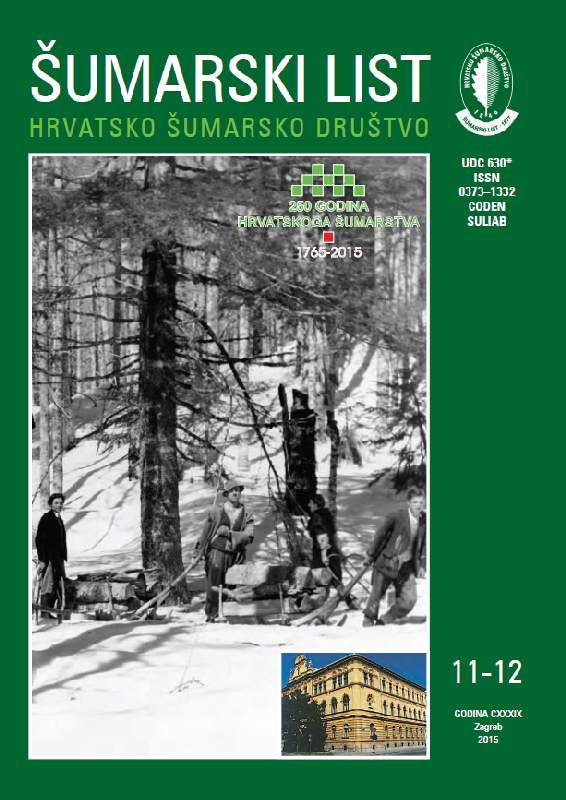
broj: 11-12/2015
pdf (10,08 MB) |
|
||||||||||||||
| RIJEČ UREDNIŠTVA | ||
| Uredništvo | ||
| AT THE END OF THE YEAR pdf HR EN | 495 | |
| IZVORNI ZNANSTVENI ČLANCI | ||
| Ivica PAPA, Tibor PENTEK, Hrvoje NEVEČEREL, Kruno LEPOGLAVEC, Andreja ĐUKA, Branimir ŠAFRAN, Stjepan RISOVIĆ | UDK 630* 383 +386 (001) | |
| THE ANALYSIS OF THE TECHNICAL FEATURES AND DRAINAGE SYSTEM FOR EXISTING FOREST ROADS IN ORDER TO ESTABLISH THE NEEDS OF THEIR RECONSTRUCTION – A CASE STUDY pdf HR EN | 497 | |
| Dalibor BALLIAN, Benjamin JUKIĆ, Besim BALIĆ, Davorin KAJBA, Georg von WÜEHLISCH | UDK 630* 181.8 (001) | |
| PHENOLOGICAL VARIABILITY OF EUROPEAN BEECH (Fagus sylvatica L.) IN THE INTERNATIONAL PROVENANCE TRIAL pdf HR EN | 521 | |
| Vesna KRPINA | UDK 630*272 + 934 + 468 (001) | |
| ANALYSIS OF THE RELATION BETWEEN VISITORS AND PROTECTED NATURAL AREAS IN THE ZADAR COUNTY pdf HR EN | 535 | |
| Omer KUCUK, Ertugrul BILGILI, Paulo M. FERNANDES | UDK 630* 431 (001) | |
| FUEL MODELLING AND POTENTIAL FIRE BEHAVIOR IN TURKEY pdf HR EN | 553 | |
| Summary Description of fuel characteristics is an essential input to fire behavior models that can provide decision-support for fire management. Fuel models describe fuel characteristics for fire modeling systems based on Rothermel’s fire spread model. In this study, fire behavior data collected in field experiments in different fuel complexes in Turkey is used in the process of fuel model development. Nine fuel models were built for low and tall maquis, Anatolian black pine (P. nigra J.F. Arnold subsp. nigra var. caramanica (Loudon) Rehder), litter, and slash variable in age and load. BehavePlus simulations of fire rate of spread, flame length and fireline intensity for typical summer weather conditions highlight the quite different fire potential between the studied fuel types. The difficulty in dealing with fuel complexes dominated by live fuels was evident from the simulations. On the contrary, the model correctly predicted the observed temporal decrease of fire behavior in slash. This study shows the crucial importance of experimental fire data to parameterize fuel models. Key words: Fuel modeling; experimental fires; fire behavior; fire modeling systems; Turkey | ||
| PREGLEDNI ČLANCI | ||
| Julije DOMAC, Stjepan RISOVIĆ, Velimir ŠEGON, Tibor PENTEK, Branimir ŠAFRAN, Ivica PAPA | UDK 630* 537 + 831 | |
| CAN BIOMASS TRIGGER AN ENERGY-WISE TRANSITION IN CROATIA AND REST OF SOUTHEASTERN EUROPE? pdf HR EN | 561 | |


